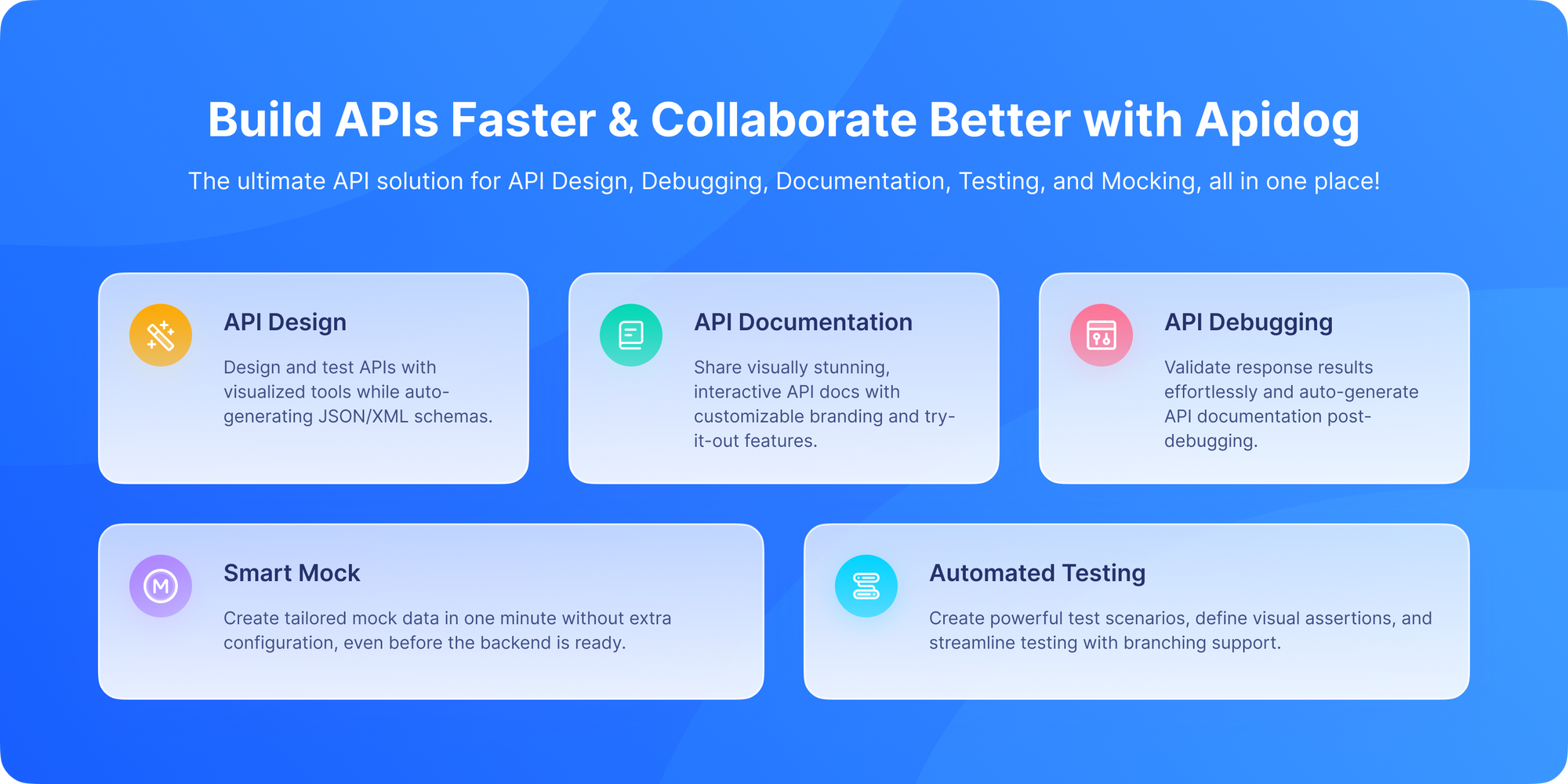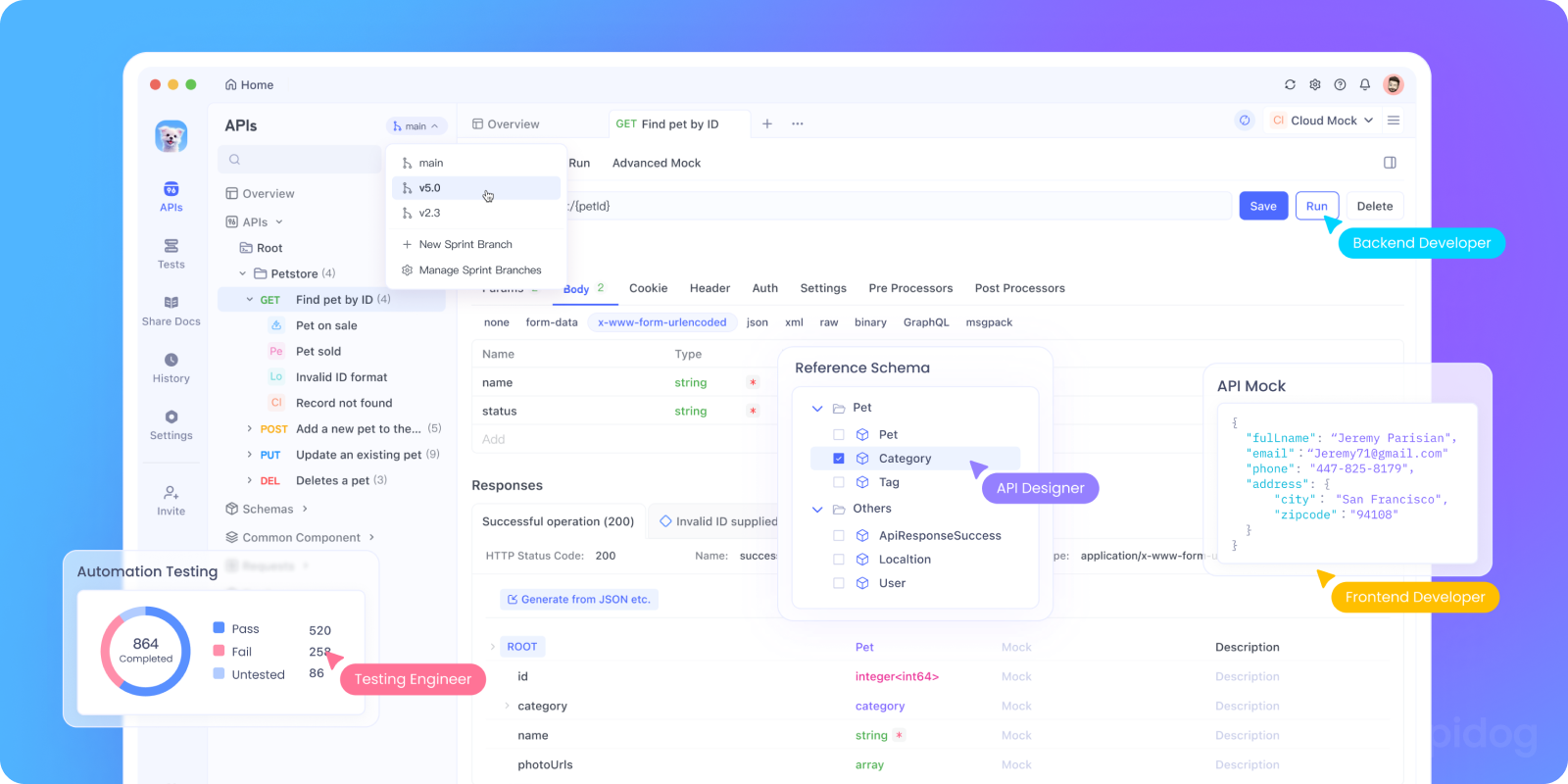APIs are the backbone of modern digital ecosystems. Whether it's mobile apps, SaaS platforms, IoT devices, or enterprise software, APIs are constantly exchanging data, connecting services, and facilitating user interactions. They're the invisible threads stitching together the digital world. But with this connectivity comes risk.
Insecure APIs have become one of the most common attack vectors for cybercriminals. From unauthorized access and data leakage to account hijacking and privilege escalation, vulnerabilities in APIs can cause significant financial and reputational damage.
That’s why API security testing is not just a good practice; it’s essential.
Want an integrated, All-in-One platform for your Developer Team to work together with maximum productivity?
Apidog delivers all your demands, and replaces Postman at a much more affordable price!
Why an API Security Testing Checklist Matters
An API security testing checklist is crucial because it provides a consistent, structured approach to identifying and fixing vulnerabilities in APIs—one of the most targeted components in modern applications.
By standardizing tests across teams, ensuring early detection of security flaws, supporting compliance requirements, and promoting continuous validation as APIs evolve, the checklist significantly reduces the risk of data breaches and enhances overall system security. It also offers traceability and accountability, making it easier to maintain a strong security posture throughout the development lifecycle.
Key Risks of Insecure APIs:
- Data breaches (leaking sensitive or personally identifiable information)
- Unauthorized access to user accounts or admin privileges
- Exploitation through injection attacks (SQL, NoSQL, etc.)
- Service disruptions due to DoS or DDoS attacks
As APIs proliferate, the attack surface grows. API security testing helps shrink that surface by proactively identifying and resolving vulnerabilities before they are exploited.
API Security Testing Checklist
1. Authentication and Authorization Validation
Authentication confirms who you are, authorization confirms what you can do. Weaknesses here lead to privilege escalations, account takeovers, and lateral attacks.
What to Test:
- Validate JWT/OAuth tokens for expiration and revocation
- Confirm object-level (BOLA) and function-level access controls
- Enforce scopes and roles strictly across endpoints and services
- Test multi-factor authentication, especially for high-risk functions
- Check session hijacking and replay attack resiliency
- Assess horizontal and vertical access controls
Even a single endpoint lacking authorization checks can be catastrophic.
2. Input Validation and Injection Protection
Bad inputs cause SQL injection, XXE, XSS, and other attacks that can ruin backend data or execute rogue code.
What to Test:
- Validate and sanitize every incoming parameter
- Use fuzz testing to try unexpected or malicious inputs
- Check that output encoding prevents XSS attacks
- Test XML handling for XXE vulnerabilities
- Confirm database queries use sanitized parameters or prepared statements
- Review payload size limits to avoid buffer overflows
3. Rate Limiting and Throttling
APIs must avoid abuse by limiting excessive or brute force requests that cause service outages or data scraping.
What to Test:
- Enforce rate limits per user/IP/application
- Try bypassing rate limits with IP rotation or header spoofing
- Ensure API quotas trigger proper throttling responses
- Validate Denial-of-Service mitigation strategies
- Load test under heavy traffic conditions
- Confirm alerting on unusual usage patterns
These tests can be scripted and run in controlled environments. Include them in performance and stress testing scenarios.
4. Data Exposure and Privacy Controls
APIs frequently leak sensitive data unintentionally personally identifiable information (PII), internal system data, etc.
What to Test:
- Minimize response payload fields (only send what’s needed)
- Check for internal object references leaking (IDs, tokens)
- Validate encryption in transit (TLS 1.2+) and at rest
- Test logging and debugging data hides sensitive info
- Review compliance with GDPR, HIPAA, PCI-DSS
- Test unexpected query parameters for data leaks
5. Error Handling and Exception Management
Verbose error messages can expose internal details to attackers, aiding in exploitation.
What to Test:
- Validate error codes follow standards (e.g., 400, 403, 404, 500)
- Check that error responses do not reveal stack traces or sensitive info
- Assess how the API manages unexpected exceptions
- Verify logging captures enough info without exposing secrets
- Simulate error conditions to test failsafe
- Ensure uniform response format for client-side parsing
Apidog is testing and documentation capabilities can help teams catch verbose or improperly structured error responses during development.
6. Security Headers and Transport Security
Implementing security headers can prevent attacks like clickjacking, content sniffing, and ensure data integrity in transit.
What to Test:
- Confirm HTTPS enforced for all endpoints
- Validate Content Security Policy (CSP) headers
- Check for HTTP Strict Transport Security (HSTS)
- Verify X-Frame-Options to prevent clickjacking
- Confirm X-Content-Type-Options header is set
- Test CORS policy restrictiveness and safety
7. Business Logic and Workflow Testing
Even if technical security is perfect, workflow vulnerabilities can let attackers bypass rules (e.g., pay zero dollars, escalate privileges).
What to Test:
- Walk through common workflows to find logic flaws
- Test role-based restrictions throughout multi-step processes
- Simulate account takeovers and cross-user operations
- Validate workflows for concurrency and race conditions
- Check transaction integrity and rollback mechanisms
- Test for data leakage in process transitions
8. API Discovery and Inventory
You cannot protect what you don’t know. Shadow or zombie APIs expose unexpected attack surfaces.
What to Test:
- Use automated tools to map all active endpoints
- Check undocumented or forgotten APIs
- Compile inventory with detailed attribute data
- Monitor runtime request patterns for anomalies
- Review API versioning and deprecation practices
- Enforce secure shutdown for obsolete endpoints
9. Security Testing Automation and Continuous Integration
Manual testing is not scalable or reliable. Automated, integrated testing prevents regressions and rapidly evolving threats.
What to Test:
- Implement automated DAST/SAST tools in pipelines
- DevSecOps integration for real-time alerts
- Manage test cases covering all API security scenarios
- Use mock data and synthetic traffic for early detection
- Automate compliance checks (GDPR, PCI-DSS)
- Schedule regular regression security tests
10. Monitoring, Alerting, and Incident Response
Even the best-tested API can be attacked. Monitoring detects suspicious activity early; alerting triggers rapid response.
What to Test:
- Real-time logging of usage, errors and anomalies
- Alerting on spikes, unusual IPs, or failed authentications
- Track sensitive data access
- Ensure logging protects PII and regulatory info
- Validate incident response workflows
- Integrate metrics with SIEM and threat intel feeds
11. Business Logic Vulnerabilities
Not all vulnerabilities are technical. Some are logical.
Example Scenarios:
- Can a coupon be reused multiple times?
- Can an account switch payment methods without reauthentication?
- Can a user manipulate prices by modifying client-side data?
These often require exploratory and scenario-based testing. Apidog supports multi-step test cases to simulate realistic workflows.
How Apidog Supports Secure API Development Practices

Managing all these tests sounds like a full-time job, right? That's why Apidog is a game changer for your team. While Apidog isn’t a dedicated security scanner, it plays a critical supporting role in the broader security strategy:
- Unified platform: Design, test security, monitor, and document APIs in one place.
- Automated security testing: Run test cases, simulate attacks, and check OWASP top threats without scripting hassles. Spot and resolve vulnerabilities before they reach production.
- No-code friendly: Everyone from security experts to new developers can contribute.
- API mocking: Frontend and QA teams can get secure early access to realistic API behaviors.
- Collaboration: Share results, assign fixes, and track progress effortlessly.

Try Apidog for free and bring security testing out of the shadows and into your developer workflow.
Insecure APIs often stem from chaotic, undocumented, or inconsistent development workflows. Apidog addresses that head-on by creating structured, transparent, and testable environments.
Final Thoughts & Action Plan
APIs are powerful and that power comes with responsibility. You can’t rely solely on firewalls and authentication to protect your data. Security testing must become a daily habit.
Action Plan:
- Start with this checklist and evaluate your current APIs.
- Introduce security testing at every stage of development.
- Use tools like OWASP ZAP, Burp Suite, and your own test harness.
- Use Apidog to structure your test plans, mock environments, and document expectations.
- Create a feedback loop between developers, testers, and security analysts.
API security testing covers a wide scope from validating authentication to spotting business logic flaws and monitoring in production. By following a comprehensive checklist and using the right tools like Apidog, you can significantly reduce your exposure and deliver safer APIs.
API security isn’t a one-time audit. It’s a process. The earlier and more consistently you test, the safer your systems and users will be.



